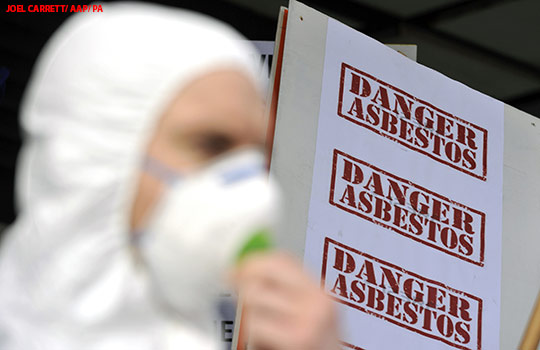 Chrysotile asbestos comprises 95% of all asbestos sold during the past century and for the past 30 years has represented the totality of the global asbestos trade.[1]
Chrysotile asbestos comprises 95% of all asbestos sold during the past century and for the past 30 years has represented the totality of the global asbestos trade.[1]
The scientific consensus is clear that all forms of asbestos are harmful and should be banned.[2, 3, 4, 5] In light of clear evidence linking asbestos to lung cancer, mesothelioma, and asbestosis, the World Health Organization (WHO) has called for an end to any use of asbestos.[6, 7, 8]
Studies linking inhalation of asbestos fibres to lung disease started to emerge as early as the 1930s. By the 1980s, as evidence of harms mounted, the asbestos industry faced extinction as its longtime customers in industrialized countries planned to ban or stop using asbestos. The industry created new markets in developing countries, claiming that chrysotile asbestos can be safely used,[9] and for the past 30 years, it’s been calculated that two million tons[10] of asbestos have been sold every year and placed in homes, schools, and buildings—mostly in Asia.
The United Nations Rotterdam Convention regulates trade in hazardous substances. It requires exporting countries to obtain prior informed consent from any country to which they wish to ship a substance on the convention’s list of hazardous substances. Thus the convention empowers countries to protect their populations by refusing or setting conditions over the import of hazardous substances.
Yet for over 10 years, a tiny number of countries have refused to allow chrysotile asbestos to be put on the convention’s list, even though the convention’s expert scientific body has repeatedly recommended its listing, stating that chrysotile asbestos meets the convention’s criteria for listing.[11]
At the convention’s conference in Geneva this week and next week (from 24 April to 5 May), the recommendation to list chrysotile asbestos will once again be put forward. The convention will also consider a proposal by a dozen African countries to amend the convention to allow a 3/4 majority vote to list a hazardous substance if consensus proves impossible.[12]
The Rotterdam Convention was specifically created to address the double standard whereby hazardous chemicals and pesticides that are banned or severely restricted in industrialized countries are increasingly being shipped to developing countries, where there are few resources to manage them safely. Thus, as populations in the global North gain greater protection from harm from hazardous substances, populations in the global South are increasingly exposed to such harm. The Rotterdam Convention seeks to stop this injustice by providing the modest but critical right of prior informed consent.
In 2011, Canada, then a major asbestos exporter, supported by four other countries, refused to allow chrysotile asbestos to be listed as a hazardous substance.[13] Canada no longer exports asbestos and is now supporting and advocating for the listing of chrysotile asbestos at the Geneva conference. But other countries that export asbestos are continuing to block the listing of chrysotile asbestos.
Russia and Kazakhstan currently represent 82% of all asbestos export. They, along with a handful of other countries, are seeking to keep chrysotile asbestos off the Rotterdam Convention’s list of hazardous substances, and to also defeat the proposed amendment that would allow decisions to be made by a 3/4 majority vote if consensus proves impossible.
The Basel and Stockholm Conventions also regulate toxic substances and work conjointly with the Rotterdam Convention. Both the Basel and Stockholm Conventions allow a majority vote when consensus proves impossible. It makes sense and is clearly imperative that the Rotterdam Convention be amended to likewise enable a majority vote to list hazardous substances. If this is not done, then the ability of hazardous industries to block the right provided by the convention will continue endlessly. Countries have a right to control the import of hazardous substances, but a right that cannot be implemented is no right at all.
The undermining of public health policy by the asbestos industry must be stopped. At the Rotterdam Convention conference, countries must ensure that chrysotile asbestos is listed as a hazardous substance, and if asbestos exporting countries refuse, then the convention must be amended to allow a majority vote decision.
Kathleen Ruff is a senior human rights adviser at the Rideau Institute, Ottawa, Canada, and founder and co-coordinator of the Rotterdam Convention Alliance. She has worked intensively for the past nine years with scientists in Canada and around the world to stop the use of asbestos.
Competing interests: I have read and understood BMJ’s policy on declaration of interests and declare I have no competing interests to declare.
References
1. World Asbestos Production by Type, 1900 to 2012. US Geological Survey. Figure available at http://www.rightoncanada.ca/wp-content/uploads/2016/01/World-asbestos-production-by-type-1900-to-20121.jpg
2. International Agency for Research on Cancer. Asbestos (chrysotile, amosite, crocidolite, tremolite, actinolite, and anthophyllite). 2012; Vol. 100c. http://monographs.iarc.fr/ENG/Monographs/vol100C/mono100C-11.pdf
3. International Commission on Occupational Health. ICOH Statement on Global Asbestos Ban and the Elimination of Asbestos-related Diseases. 2013. http://www.icohweb.org/site/news-detail.asp?id=83
4. Joint Policy Committee of the Societies of Epidemiology. Position Statement on Asbestos. 2012. https://www.ijpc-se.org/documents/03.JPC-SE-Position_Statement_on_Asbestos-June_4_2012-Full_Statement_and_Appendix_A.pdf
5. World Federation of Public Health Associations. Global ban on the mining and use of asbestos. 2005. http://www.wfpha.org/tl_files/doc/resolutions/positionpapers/enrivonment/GlobalBanMining&Asbestos.pdf
6. World Health Organization. Elimination of asbestos-related diseases. 2006. http://whqlibdoc.who.int/hq/2006/WHO_SDE_OEH_06.03_eng.pdf
7. World Health Organization. Asbestos: elimination of asbestos-related diseases. Fact Sheet. Updated June 2016. http://www.who.int/mediacentre/factsheets/fs343/en/index.html
8. World Health Organization. Chrysotile Asbestos. 2014. http://www.who.int/ipcs/assessment/public_health/chrysotile_asbestos_summary.pdf
9. Asbestos Fibre Types and Health Risks: Are Perceptions Related to Facts? Chrysotile Institute website. http://www.chrysotile.com/data/Orange_anglais_lr.pdf
10. Virta, R. Asbestos Production, Trade, and Consumption in 2014. US Geological Survey. Worksheet for world asbestos consumption calculations available at http://www.rightoncanada.ca/wp-content/uploads/2016/01/World-asbestos-data-2014.pdf
11. Chemical Review Committe. CRC 1 report: Chysotile asbestos, UNEP/FAO/RC/CRC 1/28.
http://www.pic.int/TheConvention/Chemicals/RecommendedtoCOP/Chrysotileasbestos/tabid/1186/language/en-US/Default.aspx
http://www.pic.int/Portals/5/chemicals/Inf-Exchange/chrysotile.doc
12. Intersessional work on the process of listing chemicals in Annex III to the Rotterdam Convention, UNEP/FAO/RC/COP.8/16/Add.1. http://www.pic.int/TheConvention/ConferenceoftheParties/Meetings/COP8/Overview/tabid/5311/language/en-US/Default.aspx
13. In brief: White asbestos is kept off list of hazardous chemicals. BMJ 2011;342:d4084. http://www.bmj.com/content/342/bmj.d4084
